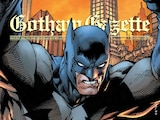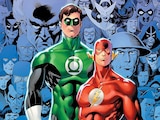In 2000, writer Christopher Priest and artist Shawn Martinbrough came together to tell a story of the one neighborhood in Gotham overlooked by Batman and the GCPD. This was Batman: The Hill, and it introduced us to a community driven far away from hope, with corrupt public figures sucking the goodwill from its impoverished citizens. In confronting the evil residing in the Hill, Batman had to come to terms with the limitations of his own methods.
Nearly twenty-five years later, Martinbrough is returning to the most dangerous street in Gotham with a new protagonist and a story of a gentrified community choosing to fight back against corruption and defend their own. Intriguingly, Martinbrough has switched duties this time around, scripting Red Hood: The Hill while leaving the pencils and inks to artist Sanford Greene. Red Hood: The Hill sees Jason Todd return to the neighborhood he once called home, finding himself in the middle of a conflict between aspiring vigilantes and the descendants of those who preyed on the Hill in years’ past.
We recently spoke with Martinbrough about his approach in writing this successor to his earlier Bat-classic and what makes Red Hood the right hero for this return.

Batman: The Hill was published nearly twenty-five years ago. What was the concept for that story back then, and what led to you returning to it all these years later?
In 1999, I worked with writer Christopher Priest, who had a very interesting idea for a neighborhood that was rough and neglected and one that Batman never set foot in. Originally it was a fourteen-issue maxiseries, but eventually got cut down to forty pages. However, I think the story remained resonant regarding concepts of neglect. In designing a section of Gotham from the ground up, I put a cemetery in the center of it as a metaphor for how bleak life was living in the Hill.
Years later, [Batman group editor] Ben Abernathy approached me to write a two-part Red Hood story that took place between “Joker War” and “Future State.” I thought about how to make a story that wouldn’t necessarily change him, but give readers a new experience. As far as I know, the Hill had never been expanded on since Christopher Priest and I created it, so I thought about what it might be like twenty years later. As with all major metropolitan cities, it’s usually prime real estate and gets gentrified. I thought that would be an interesting theme to play with. And tying it into “Joker War,” which was a very insane Purge-like event where different people were running around in masks causing havoc, I thought “What if you lived in a neighborhood and you saw that, and people began banding together to defend the neighborhood against this coming onslaught?”
That was the premise for Red Hood: The Hill.

Part of the essence of The Hill is the struggle of normal people against criminals who present a normal face—such as Demetrius Korlee, and now his son Junior. How should these characters be viewed, as well-meaning individuals who’ve lost their way? Or more deceptive characters?
It’s all the above. Everyone has their own agenda. You’ve got people who are well-meaning, and others who want what other people have and will do whatever it takes to get it.
Actually, in the six-part sequel there is one character who is pure and innocent…and that character is the most tragic character in the story. I’ll let the readers figure out who that is.
In the original Hill story, we saw the limits of Batman’s traditional methods on an impoverished community. How will Red Hood’s methods differ, and will he run into similar obstacles?
Red Hood differs from Batman in how he doesn’t have any limits. He is more than willing to kill or tear the bad guy apart, which Batman wouldn’t do. It was interesting to turn that characterization on its head and make Jason watch other rising crimefighters and say, “Wait, maybe you don’t want to cross those lines because it will have ramifications for you and your mental health.”
I thought that was an interesting way for him to see a bit of himself in Strike and other vigilantes, to see her and say, “Maybe I can now see what Bruce was talking about.”

Did you intend this story to be a character development arc for Jason Todd, or to further flesh out the Hill as a Gotham City landmark?
Really both. This story takes place in the past, between “Joker War” and “Future State.” I wasn’t able to drastically change Jason Todd, so as to not contradict the character he is now, but I could play around the edges with him. I did want to play with the different sides of his personality and present those different sides to the readers. Also, at the end of the initial two-part story, Jason tells Dana he’s not staying. Kind of like a western where he intends to leave the town and ride off into the sunset.
But at the start of the new six-part story, he’s still there. So, it’s an opportunity to play with Jason and show off new layers, but at the same time develop the Hill further with the idea that it’s a changing part of the city at this specific moment in time.
Last question. There has been an increase in tackling real systemic and political issues in superhero comics over the past few years. Do you find that it’s difficult to craft a story meant to resonate with readers in a more grounded, frank way when writing in a genre that eventually demands a stable status quo?
I don’t find it to be a challenge. Whenever I come up with a story, I try to find the journey that particular character must go on. Then, when coming up with point A to point C, I think of what those individual challenges would be. With the two-part Red Hood story, I approached it like a western. And with this six-part story, I approached it like The Wire, which to me is the greatest television show ever made. That show carried through so many different types of characters with different kinds of agendas from different walks of life, and they eventually interconnected. That was my goal in crafting Red Hood: The Hill.
Red Hood: The Hill #1 by Shawn Martinbrough, Sanford Greene and Matt Herms is now available in print and as a digital comic book.















